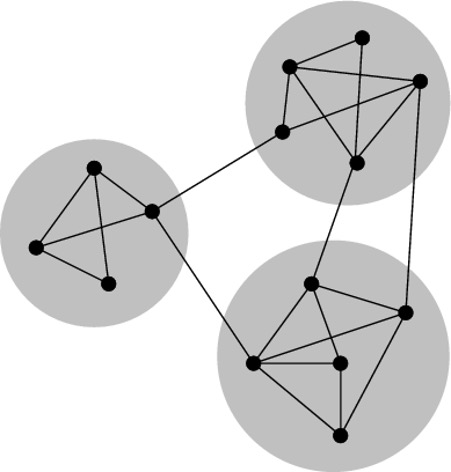1.5. System structures
1.5. System structures
In the following section, we will look at how systems work, but before that, it is useful to take a quick look at the main structural features of systems, as they play an important role in system functioning.
More than the sum of its parts
Systems are often said to be more than the sum of its parts. This means that the connections between the elements of a system achieve something more than the elements of the system without those connections.
To use an already familiar example: a football team with a good strategy and a good team spirit beats a team of equally skilled players with no strategy or team spirit. Strategy and team spirit allow players to act in a coherent way towards a common goal.
The functional links in a system are therefore often more important than the individual elements. In many systems, the elements can be replaced without the system changing much. For example, a football team can change one player for another and still be the same team.
But if you change the functional links or the purpose of the system, the system will change, even if all its elements remain the same. If a team of the same players changes its playing strategy, the nature of the team changes. And if the rules of the game are changed from football to basketball, it is no longer a football team but a basketball team.
Interconnections between elements
Functional interconnections between elements of a system refer to the impact of elements on other elements and thus on the system as a whole. In an ecosystem, for example, decomposers release nutrients that plants use to grow, thereby affecting the productivity and abundance of different organisms in the ecosystem as a whole.
The mechanisms of interactions in systems can be very diverse. In physical systems, they can be simply the movement of matter, such as the flow of water from a reservoir to a river or the transport of oxygen from the lungs to the muscles in the bloodstream.
In many systems, however, the most important interactions take place through the transfer of information. For example, the human ability to respond to external events is based on information transmission, whereby information from the outside world is first transmitted through the sensory nerves to the central nervous system, which then controls the body's appropriate action through nerve impulses and hormones.
The mechanisms of information transmission can be very difficult to detect, much more difficult than the movements of matter. There are countless different ways of transmitting information in human communities. Speech, facial expressions and body language are examples of ways in which people can communicate with each other. There are also many technical tools for communication, such as information networks, books and telephones.
The customs and norms of a community are information embedded in the culture, which greatly influences how the community operates. This knowledge is largely absorbed in childhood and adolescence and influences all activities in society. The norms of communities are discussed in the fourth section of this course.
In Finland, for example, there is a high level of public trust in fellow human beings and authorities, which helps to explain how well Finnish society functions. However, trust is much more difficult to observe than the material components of a system, such as people and infrastructure, and therefore may not receive as much attention as its importance for the system would warrant.
System elements
While interconnections are essential to the functioning of systems, the elements of the system are of course not without importance. For there to be interconnections at all, there must also be elements between which the interconnections exist. Exactly what is considered to be elements of a system depends on the system under consideration and the scale of the analysis.
For example, when looking at biological systems at the scale of a large ecosystem, the different levels of the food chain (producers, consumers, decomposers) can be understood as elements of the system, but when looking at an individual animal, for example, the different parts of the body (muscles, digestive system, circulatory system, etc.) can be understood as elements.
System size
The number of elements in a system is one of the most important structural features of the system. Systems comprising only a few elements are usually different from systems comprising millions of elements. It is of course necessary to first define what is meant by the elements of a system in each situation.
The number of cells in organisms is one clear example of the size of a system. Single-celled organisms are very simple in their function, since this single cell must be able to carry out all the functions necessary for the organism. In unicellular organisms, the functions are therefore limited mainly to metabolism and reproduction; their abilities to move, communicate, process information, etc. are, by and large, very limited.
Multicellularity allows for diversification of functions, as different cells can perform different tasks. In the most primitive multicellular organisms, the first division of labour is reproduction. Some cells specialise as gametes, i.e. they are responsible for the reproduction of the organism, while other cells are responsible for the metabolism of the organism, i.e. the supply and processing of the energy and nutrients needed for reproduction and growth. Examples of such organisms are certain microscopic algae, which consist of a few hundred cells.
As the number of cells increases, the potential for division of labour between cells increases. In the human body, for example, there are about 30 to 40 trillion (thousand billion) cells, from which more than 200 different cell types can be distinguished. This cellular differentiation, which is only possible when there are many cells, enables humans (and larger animals in general) to perform a wide range of functions: locomotion, multiple ways of sensing the environment, complex information processing, and so on. As the size of an organism increases, so do the needs for new functions. For example, while microscopic primitive organisms take oxygen directly from the environment through cell walls, larger animals need a circulatory system to transport oxygen to different parts of the body.
Similar relationships between system size and diversity of functions can be observed at many different levels of systems. For example, in ants, the number of different kinds of worker castes (such as soldiers and brood care workers) is greatest in those ant species with the largest societies.
In humans, the range of occupations in modern societies of millions of people is enormous, whereas in hunter-gatherer societies of a few hundred people, the division of labour has been much less pronounced. And just as in the case of multicellular organisms, as human communities have grown, so too has the need for new functions, such as the management of different systems, whose main purpose is simply to maintain the system itself and enable it to function.
Modularity
Larger systems and networks often have a modular structure, i.e. a system consists of groups of closely interconnected elements (modules). There are also links between groups, of course, but these are not as strong as the links between elements within groups. For example, human communities can be thought of as consisting of families, within which the links are stronger than between families.

Figure. A modular network consists of closely interconnected groups of elements (modules). There are also links between modules, but they are not as dense. Credit Nog33, Public domain, via Wikimedia Commons
Modular structure can make the system more resilient to different types of disturbance. If a serious malfunction occurs in one group, the malfunction is likely to stay within the group and not spread to the entire system, as the groups are functionally independent. We will find many examples of this in the coming sections.
Modularity also makes it easier to develop new solutions, as different approaches can be tried in different groups without having to change the whole system. In biological evolution, for example, individuals of the same species can be considered as modules, to which mutations introduce new traits. Harmful mutations are eliminated when the individuals carrying them die, and beneficial mutations become widespread when the individuals carrying them reproduce and pass the mutation on to their offspring.
In product engineering, modularity means that the development work and the final product are done in parts that are joined together to form a final product. For example, computer software can be designed as separate components, each of which performs its own function. Separate pieces of software can then be coded and tested separately, making development and problem identification and correction easier.
In product engineering, modules are therefore not alike, but rather parts of the system that perform different functions, in the same way that different human organs (heart, liver, kidneys, etc.) perform different functions. This modularity does not necessarily protect the system from failure (all organs are vital), but it does allow for easier repair and maintenance of the system provided that the components are easily interchangeable.
Hierarchy
Large systems are typically not only modular but also hierarchical, i.e. they consist of nested systems. Consider, for example, the human being: a human being is made up of cells, which then form tissues, which form organs, which finally form the human body. And you can keep going up the hierarchy: people form families and neighbourhoods, which form villages and cities, which form states.
The hierarchy of a system thus allows for the emergence of larger - and more complex - systems, as discussed in the section on the size of systems.
Higher-level systems tend to evolve to serve the needs of lower-level systems. For example, traffic rules and the police that enforce them (the upper hierarchical level) are created to serve the safer movement of community members (the lower hierarchical level). Community members have therefore given up some of their freedom - such as the freedom to drive on the left-hand side of the road - because this increases safety and therefore real freedom of movement.
In hierarchical systems, the higher hierarchical level usually always coordinates or controls the lower hierarchical level. The coordination and control that comes from the hierarchy enables the whole system to acquire new functions and features.
In other words, societies need systems to take care of things that individuals are unable to do themselves, or that are otherwise seen as sensible to be done by a common system. How these systems should be built and how they should be managed is a fundamental question of social life, and recent anthropological research shows that human history is replete with a wide variety of solutions to these questions (see https://en.wikipedia.org/wiki/The_Dawn_of_Everything).
In the light of history, strictly top-down societies have not provided the best possible life for their citizens; in particular, individual freedoms have suffered. In modern democracies, the growing power of the upper hierarchy over individuals is limited, inter alia, by electing new decision-makers at short intervals and by limiting the number of terms in office of those in the highest positions of power.
Would you like to comment something on this section? Voluntary.
